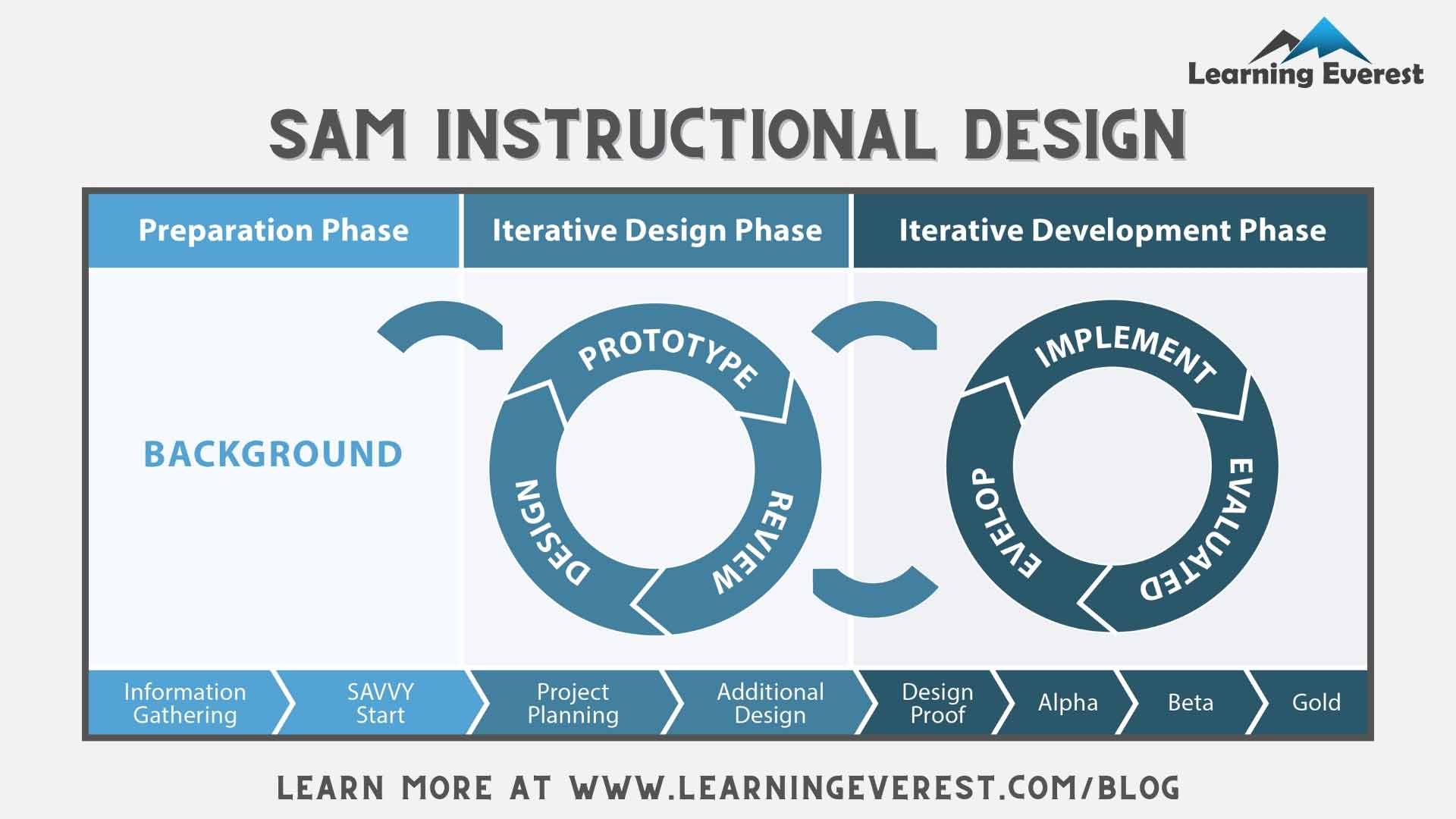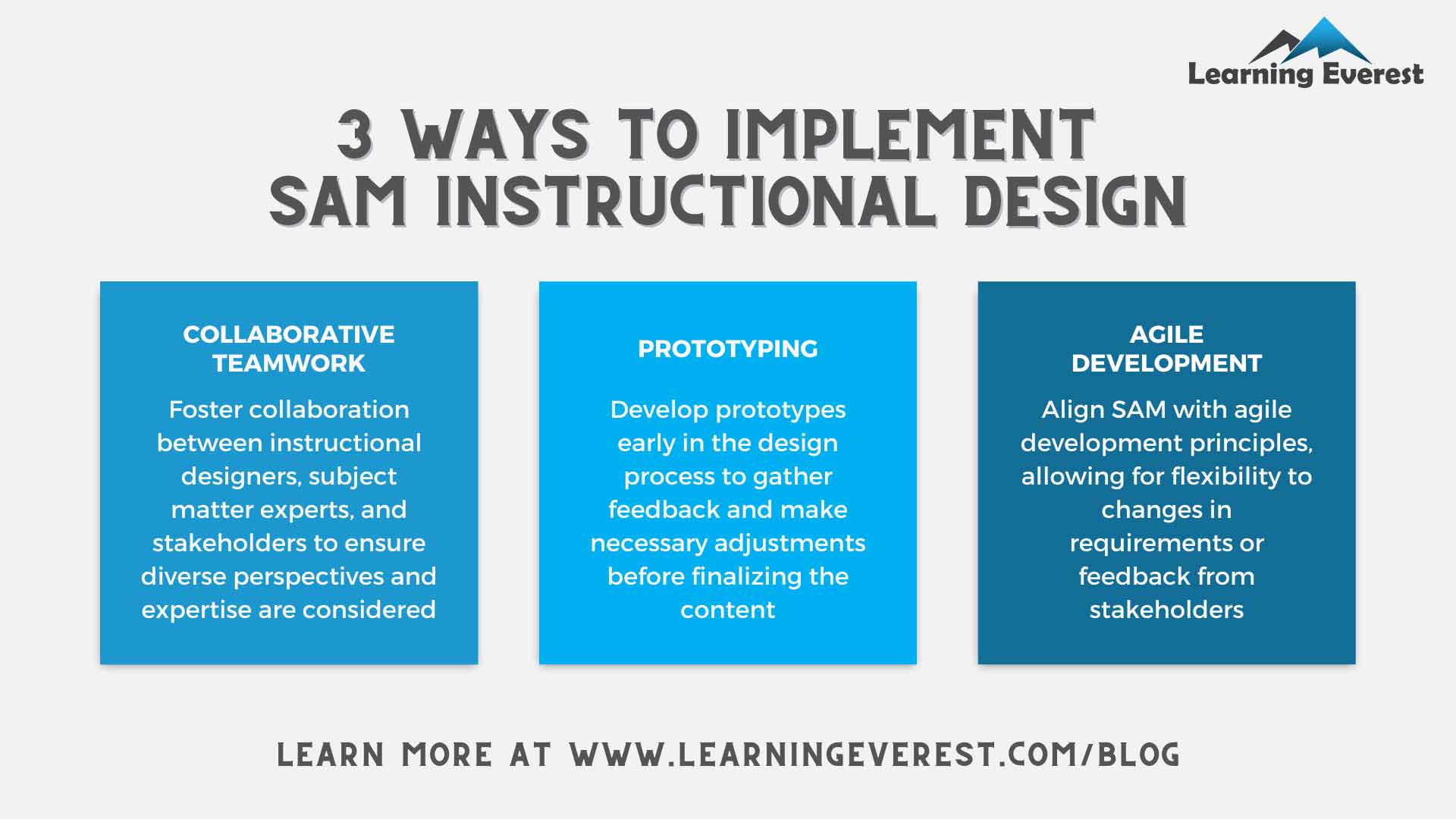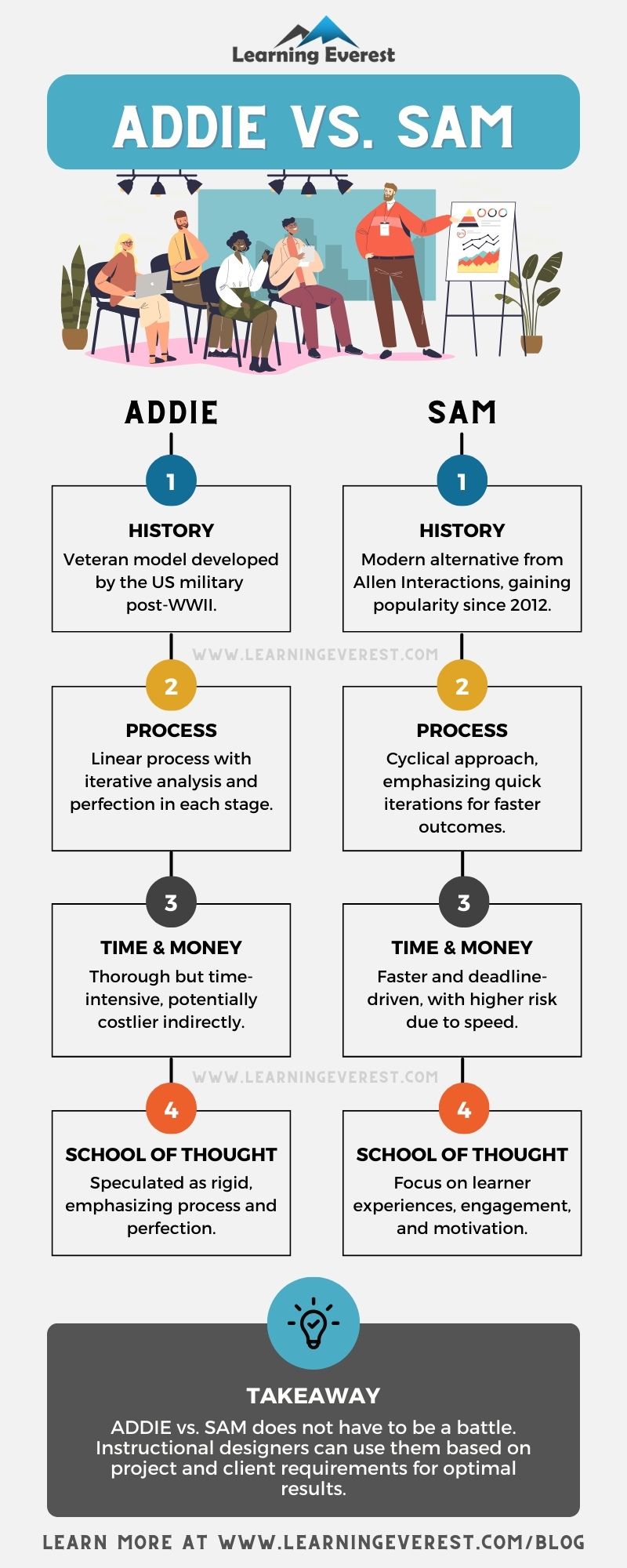Creating training and development content that drives measurable results is tricky. It is difficult to design instructionally comprehensive and performance-based eLearning content. Creating effective training content starts with instructional design. Instructional designers use instructional design models to define the activities that will guide the development of training modules. It allows them to communicate the purpose and reason behind a strategy.
Table of Contents
- What is a SAM instructional design model?
- Phases of SAM instructional design
- Benefits of the SAM instructional design model
- Disadvantages of the SAM instructional design model
- Conclusion
- Infographic
- Knowledge check!
- Frequently Asked Questions (FAQs)
- What is instructional design?
- What does SAM learning stand for?
- What is the SAM instructional design model?
- What is the ADDIE instructional design model?
There are several instructional design models that instructional designers use to generate different scenarios. ADDIE is the most well-known instructional system design (ISD) model. The capacity to develop projects swiftly and effectively is one of the many benefits of having an instructional design system like ADDIE. However, the linear structure of the ADDIE model becomes rigid and inflexible for instructional designers at times.
Here comes the SAM instructional design model!
What is a SAM instructional design model?
SAM stands for Successive Approximation Model. SAM is a by-product of the ADDIE model, first introduced in 2012 by Michael Allen, CEO of Allen Interactions. It is a rapid eLearning development process. It has emerged as an alternative to the waterfall approach of ADDIE, especially to deliver performance improvement.
The ADDIE model for instructional designing is a systematic, step-by-step framework that instructional designers, eLearning developers, and instructors use to ensure that course development and learning do not take place in an unorganized and random manner. In contrast, SAM rejects this linear approach of ADDIE and takes a more iterative approach to instructional design. It is an iterative design and delivery model to meet the immediate demands.
Let us have a look:

SAM instructional design
Let us discuss each of the phases in detail!
Phases of SAM instructional design
The SAM instructional design model consists of three phases:
Phase 1: Preparation
The preparation phase involves gathering all the background information on the targeted audience and defining desired outcomes for the training program. This involves identifying the resources already available and potentially conducting additional research, like surveys for target audience research or meeting subject matter experts (SMEs) to better understand the information you want to convey.
It starts with gathering background information on learners, such as,
- Who within the organization is the target audience for the training program?
- What skills do they need to acquire?
- What prior knowledge does the target audience possess?
- What is the best learning style and environment to deliver the training?
- What resources and pedagogical strategies do you use?
- What constraints do you have to operate in?
It also begins with defining the project’s outcome. Then, eLearning project coordinators, SMEs, learning experience designers, and other developers brainstorm ideas on the learning experience design and delivery methods.
Phase 2: Iterative design
The iterative design phase involves designing, prototyping, and reviewing the training solution. At this phase, training managers set the project timeline and budget and assign tasks to the relevant parties. After that, the design period starts in iterations. The storyboards, ideas, and prototypes that came out of the previous phase become more structured as the design progresses further in iterations.
The goal of this iterative design phase is for the SMEs and the stakeholders to evaluate the training solution — or alternative designs. This way, they will contribute to the solution design and eventually support the final solution. Additionally, their feedback also feeds the following design iterations, which increase the level of confidence that the solution will satisfy the training needs.
Phase 3: Iterative development
The designing team develops and implements the final solution (iteratively) during iterative development. They create a design proof representing consensus decisions obtained from the previous phase. The developers also verify the design and functionality at this phase. The iterative development phase of SAM generally contains three full releases of the final product:
- Alpha: The first version of the complete training product to evaluate the basic design of the course. This alpha version may only contain rudimentary content or placeholders that need further development.
- Beta: A modified version of the alpha version; the beta version is an update based on iterative feedback. Mainly, the beta release sets the final course structure, activities, and methodology. If the beta release requires no further changes, it may become the final gold version.
- Gold: The final one, which is ready for full deployment.
SMEs, developers, and key users can evaluate the result at each iteration. In SAM instructional design, their feedback is the input for the next iteration, which originates quicker corrections or improvements than other designing models. This approach of SAM is to prevent going over budget or delivering after the deadline.

3 Ways to Implement SAM Instructional Design
But what makes SAM instructional design so appealing to instructional designers? Let us find out!
Benefits of the SAM instructional design model
Let us discuss the significant benefits that drive the Successive Approximation Model (SAM):
1. Efficient problem solution
SAM enables us to resolve problems faster because of its non-linear structure. SAM model has six phases of design and development that run simultaneously, which makes it easy to spot a problem in any of the phases, fix it, and correct any related factors.
2. Holistic development approach
With the SAM instructional design, eLearning teams do not focus on a single result. And that makes it easier to consider when something is not working or if something else could work better. In addition, it promotes creativity, which speeds up the whole process.
3. Flexibility
SAM instructional design does not put all the effort into a single iteration or the first round of solution development. It accepts the quick development of imperfect solutions. As the developing team receives feedback from the first iteration, it becomes easier to understand what the final solution should look like. As a result, it reduces the risk of late-phase revisions by providing prototype versions early in the process, minimizing the need for major overhauls.
4. Iterative development
With ADDIE, the problem is that if the developers do not get the desired results or outcome at the end, they have to trace and make the changes from the start. In a SAM instructional design model, however, one works on all the phases simultaneously and produces a prototype version of the product before the final phase. In this approach, therefore, they do not have to wait till the end to see the final product and to see whether it works according to the learning goals or not. Making changes and fixing errors in the content of training is very easy in this approach. One can make as many corrections as they want to achieve the desired goals and objectives.
5. Tailored learning experience
Feedback from early iterations helps tailor the learning experience to accommodate employees’ learning styles and training needs effectively. It also fosters a culture of continuous improvement. The simultaneous progression of phases in SAM facilitates collaborative efforts as teams work together, promoting effective communication and coordination.
Disadvantages of the SAM instructional design model
It has a few drawbacks as well,
1. Repetition: More steps can lead to more mistakes, increasing the likelihood of errors.
2. Wasted resources: Mistakes in the process result in the expenditure of significant time and money on ideas that may not be suitable for large-scale implementation.
3. Too broad: Testing a wide range of ideas may make it challenging to determine the optimal outcome. Additionally, the need for significant analysis and research, rather than fast prototyping, can divert the team from focusing on the best approach from the outset.
Conclusion
To sum up, when applied in the right situations, SAM instructional design’s iterative approach makes it easy to get you to a successful final course in a faster way. However, applying an agile approach like SAM instructional design can be difficult when your environment does not encourage rapid feedback or flexible processes. In those cases, ADDIE’s waterfall model may be a better choice. Because ADDIE is a waterfall method used for years, it might make clients, stakeholders, and even team members more comfortable.
Infographic

SAM Instructional Design Model to Create Effective L&D Training Program
Knowledge check!
Frequently Asked Questions (FAQs)
What is instructional design?
Instructional design for eLearning is a process by which eLearning developers plan out the structure and flow of the online courses, ensuring that they have included all steps and parts in order to achieve the learning goals.
What does SAM learning stand for?
SAM stands for Successive Approximation Model.
What is the SAM instructional design model?
SAM stands for Successive Approximation Model. Dr. Michael Allen, the owner of Allen Interactions, has developed this model. It has emerged as an alternative to the waterfall approach of ADDIE, especially to drive performance improvement.
What is the ADDIE instructional design model?
ADDIE is a well-known instructional system design (ISD) model. The ADDIE model is a general, systematic, step-by-step framework that instructional designers, developers, and trainers use to ensure that course development and learning do not take place in a random manner.





